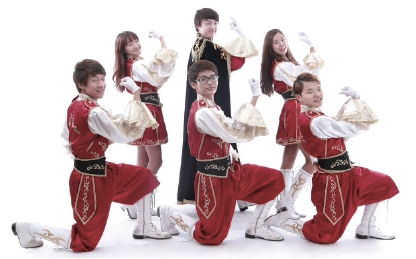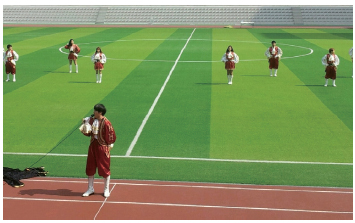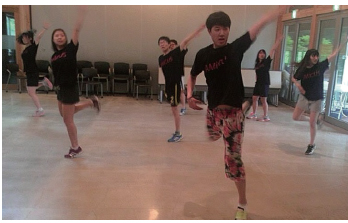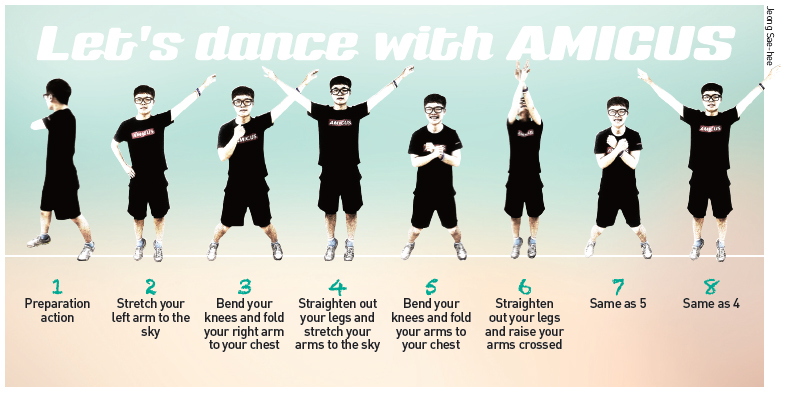

Who are the AMICUS?
“Amicus” came from a Latin word for “friend,” and our Central Club AMICUS, tried to show that it is a “friend of UOS forever.” Although AMICUS has a history of only seven years, it has quickly advanced. The AMICUS already have their own cheerleading festival at school events and publicize our school by performing at outside events. They are also an official member of the Korea University Cheerleader Association (KUCA), so they interact with other universities’ cheerleading teams.
The biggest activities of AMICUS are aedongje, Inhyangje, and freshmen orientations. However, they perform wherever they are required, not only inside of school but outside as well. Through their efforts, they have become a representative cheerleading team of our school and community. The best things about AMICUS, as Leader Goo emphasized, are not only its high quality of performance, but a family-like atmosphere. She said, “We may just have a short history, but we are so close to each other. There is no one troublesome in our club. It may be that we spent lots of time together for practice, we know each other so well. This is a mainspring of our club.”

Past and Present of University Cheering Culture
As we mentioned, university cheering culture is a symbol of people in their twenties. Moreover, the role of the cheerleading team is an important part of the college atmosphere, for it encourages a sense of belonging. In times in the past, when Korea was suffering from political oppression, university cheering culture was on the basis of resistance to society from those who had a high-class education.
Also, university sports with zestful cheerleading such as baseball and asketball were popular among students and citizens in the 1990s. During these periods, university students used cheering culture not only as a path to excitement, but as a means of expressing their opinion about society or attempting to escape political oppression.
In 21st century, with no immediate political pressure in the society, university cheering culture continued without a political purpose. However, unlike how university cheering culture was in the past, nowadays, university cheering culture is quite dead compared to before. There exist quite renowned and deep-rooted university cheerleading teams at other universities.
Those are credited for creating a school institution and are supported by their schools. Nonetheless, compared to the past, they could not catch people’s attention as much. Leader Goo shared the same opinion. Her opinion was that, especially because our school lacks proper sports teams, there are few chances to develop our own unique cheering culture and to show their performance to develop fellowship as an aspect of school. Students’ values at present also affect cheering culture.
Leader Goo said, “Nowadays, many students have a tendency to emphasize co-curricular activities so-called “SPEC” such as high GPA or a near-perfect TOEIC score and are not thinking about clubs. Because of these changes in the atmosphere, there are few students who want to join us. So, our activities do not come into the spotlight or are viewed as of little importance.”

Future of University Cheering Culture
Although the atmosphere of campus is more negative than before, the cheering culture has its own value. Goo said, “Last year, we taught the Chungryang High School cheerleading team as a talent donation. We also led the World Cup street-cheering four years ago. Few weeks ago, we participated in the Seoul Hope Show as celebration performers at Seoul City Hall.” Those activities of AMICUS show us that university cheering culture does not only serve a role as mood-maker but can give hope and dreams to citizens and teenagers in our community.
Still, there are scarce chances for us to meet AMICUS at our school except at annual events like Daedongje, Inhyangje, Jeonnongchejeon, and etc. This makes our school cheering culture hard to develop further. Although our own cheering squad, AMICUS, exists, we do not have particular moves or songs which we can follow and accept like a theme song for our school. To flourish our own cheering culture, not only AMICUS has to try to think of ways to get along with fellows, but also students need to try to create more chances to cheer and support passionately. When we come together, the campus
mood becomes more alive.
To Those who are Interested in or want to join AMICUS
Goo said, “First of all, we practice hard for our performance during the cheering festival at Inhyangje. There are various stages that communicate with the audience and collaborate with other university cheerleading teams, so we hope UOS students come to our festival and enjoy our performance. In addition, we publicize our school at outside events a lot. Therefore, we look forward to fellows keeping their eyes on us. Also, freshmen who want to join AMICUS can come to our club room and become a member at any time. We do not recruit our members officially, but the more people apply, the more amazing performance we can make. So, do not hesitate to become a member!”

All photos credited by AMICUS
Park Ji-hye Junior Reporter
pinkrabbit94@uos.ac.kr

